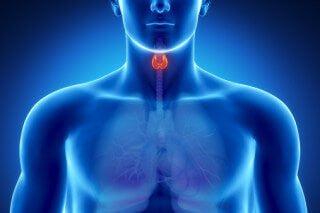Offer
Provide additional details about the offer you're running.

Written by Chris Kresser
Hippocrates said: “All disease begins in the gut.” 2,500 years later we’re just beginning to understand how right he was. And, as I’ll explain in this article, hypothyroidism is no exception. Poor gut health can suppress thyroid function and trigger Hashimoto’s disease, and low thyroid function can lead to an inflamed and leaky gut – as illustrated in the following diagram:

Have you ever considered the fact that the contents of the gut are outside the body? The gut is a hollow tube that passes from the mouth to the anus. Anything that goes in the mouth and isn’t digested will pass right out the other end. This is, in fact, one of the most important functions of the gut: to prevent foreign substances from entering the body.
Another important function of the gut is to host 70% of the immune tissue in the body. This portion of the immune system is collectively referred to as GALT, or gut-associated lymphoid tissue. The GALT comprises several types of lymphoid tissues that store immune cells, such as T & B lymphocytes, that carry out attacks and produce antibodies against antigens, molecules recognized by the immune system as potential threats.
Problems occur when either of these protective functions of the gut are compromised. When the intestinal barrier becomes permeable (i.e. “leaky gut syndrome”), large protein molecules escape into the bloodstream. Since these proteins don’t belong outside of the gut, the body mounts an immune response and attacks them. Studies show that these attacks play a role in the development of autoimmune diseases like Hashimoto’s.
We also know that thyroid hormones strongly influence the tight junctions in the stomach and small intestine. These tight junctions are closely associated areas of two cells whose membranes join together to form the impermeable barrier of the gut. T3 and T4 have been shown to protect gut mucosal lining from stress induced ulcer formation. In another study, endoscopic examination of gastric ulcers found low T3, low T4 and abnormal levels of reverse T3.
Likewise, thyrotropin releasing hormone (TRH) and thyroid stimulating hormone (TSH) both influence the development of the GALT. T4 prevents over-expression of intestinal intraepithelial lymphocytes (IEL), which in turn causes inflammation in the gut.
One little known role of the gut bacteria is to assist in converting inactive T4 into the active form of thyroid hormone, T3. About 20 percent of T4 is converted to T3 in the GI tract, in the forms of T3 sulfate (T3S) and triidothyroacetic acid (T3AC). The conversion of T3S and T3AC into active T3 requires an enzyme called intestinal sulfatase.
Where does intestinal sulfatase come from? You guessed it: healthy gut bacteria. Intestinal dysbiosis, an imbalance between pathogenic and beneficial bacteria in the gut, significantly reduces the conversion of T3S and T3AC to T3. This is one reason why people with poor gut function may have thyroid symptoms but normal lab results.
Inflammation in the gut also reduces T3 by raising cortisol. Cortisol decreases active T3 levels while increasing levels of inactive T3. 1
Studies have also shown that cell walls of intestinal bacteria, called lipopolysaccharides (LPS), negatively effect thyroid metabolism in several ways. LPS:
Hypochlorhydria, or low stomach acid, increases intestinal permeability, inflammation and infection (for more on this, see my series on acid reflux & GERD). Studies have shown a strong association between atrophic body gastritis, a condition related to hypochlorhydria, and autoimmune thyroid disease.
Constipation can impair hormone clearance and cause elevations in estrogen, which in turn raises thyroid-binding globulin (TBG) levels and decreases the amount of free thyroid hormones available to the body. On the other hand, low thyroid function slows transit time, causing constipation and increasing inflammation, infections and malabsorption.
Finally, a sluggish gall bladder interferes with proper liver detoxification and prevents hormones from being cleared from the body, and hypothyroidism impairs GB function by reducing bile flow.
All of these connections make it clear that you can’t have a healthy gut without a healthy thyroid, and you can’t have a healthy thyroid without a healthy gut. To restore proper function of the gut-thyroid axis, both must be addressed simultaneously.
Healing the gut is a huge topic that can’t be covered adequately in a few short sentences. But I will say this: the first step is always to figure out what’s causing the gut dysfunction. As we’ve reviewed in this article, low thyroid is one possible cause, but often hypochlorhydria, infections, dysbiosis, food intolerances (especially gluten), stress and other factors play an even more significant role. The second step is to address these factors and remove any potential triggers. The third step is to restore the integrity of the gut barrier. My preferred approach for this last step is the GAPS diet.
The influence of thyroid hormones on the gut is one of many reasons why I recommend that people with persistently high TSH and low T4 and T3 take replacement hormones. Low thyroid hormones make it difficult to heal the gut, and an inflamed and leaky gut contributes to just about every disease there is, including hypothyroidism. Fixing the gut is often the first – and most important – step I take with my patients.
1. Stockigt, JR and Baverman LE. Update on the Sick Euthyroid Syndrome.Diseases of the Thyroid. Humana Press, Totowa, NJ, 1997, pp.49-68